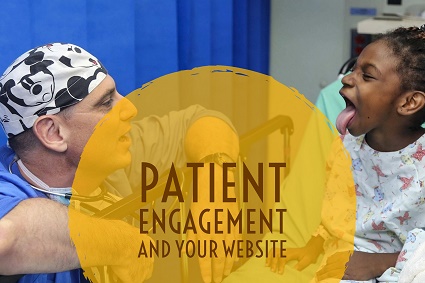Your cart is currently empty!

Patient Engagement and Your Website
Things may seem great when you’re in direct contact with your patients. It’s not so great when you read a review of your office a couple of weeks later saying you’re not responsive or that the patient couldn’t get hold of you. And it’s also not great to see that same patient with the same problem because they didn’t finish taking their medication or didn’t follow through on the lifestyle changes you emphasized. Online patient engagement can help.
Patient engagement is also an important part of meaningful use guidelines. In Stage 1, healthcare providers need to give patients appointment reminders and access to patient education materials. In Stage 2, patients should receive online access to their health care records and a secure way to communicate with their providers.
Beyond the regulations, patient engagement empowers patients, improves compliance with treatment plans, and ultimately lowers costs.
So how can your website increase patient engagement?
Your patients can keep up with their health care at your website by
- requesting appointments
- requesting prescription refills
- paying their bills
- accessing patient education materials.
By linking from your website to a secure patient portal, you can also provide patients access to their health records and allow secure messaging between patients and doctors. If you already use a certified EHR, have your web team link to the portal from your website to encourage patients to use the portal and to visit your website. That link makes things easier and more convenient for your patients.
We sometimes hear doctors and therapists in smaller practices say that certified patient portal software isn’t in their budget. There are some free and open source patient portal software options:
- OpenEMR (Stage I certified, WordPress compatible)
- Nosh Charting
- Practice Fusion (certified, ad supported, not open source)
- FreeMED
But even without a secure patient portal, you can provide patient education, appointment booking, bill pay, and even secure messaging. In the past, these things might have made it expensive to build and update your website, but WordPress’s large library of plugins (apps for your website, essentially) makes this functionality affordable.
Once you have the tech, how do you get patient buy-in?
By now, there has been a good amount of research showing that up 87% of patients will use online patient engagement opportunities, and that two thirds of those who don’t have access to their records and other online tools want that access. In fact, nearly half of healthcare consumers in a recent study said that they would switch to a different doctor in order to have access to online tools.
So you can assume that your patients want that online engagement. You have to make it easy.
We’ve seen with our medical clients that use of the patient portal increases when we provide an easy to find, easy to use link to the portal, even though there have been no changes to the portal itself. In one case, we saw a 500% increase in patient portal visits within six months.
Help patients develop the habit of using the tools by reaching out to them. Here are just a few ways that you can encourage that connection:
- Send a simple email newsletter consisting of links to seasonally appropriate blog posts at your website.
- Boost announcements of events at Facebook so your followers will see them on their timelines. Make sure to include links to your website for those who want more information.
- Create a 30 day health challenge at Facebook or Instagram. Ask patients to post pictures of their healthy snacks, something they see on their daily walk, or what they’re doing when they used to take a cigarette break. Post the challenge at your website and share favorite patient posts (remind yourself of HIPAA social media rules first).
- Send a message to patients if you know there will be a delay in their appointments.
- Offer to set up automatic reminders for patients who need help remembering to take medication or to do at-home exercise routines or other actions out of the office. You care about your patient as much as their Fitbit does, right?
Once patients can easily find and use the patient tools, they’ll experience and appreciate the benefits of tools that help them take control of their health.
Make it easy on yourself.
If you still think of your website as an online brochure, you’re working too hard.
Modern websites can be workflow hubs that automate a lot of tasks. Your care team can flag the messages that really need your attention so you don’t have to scroll through lots of messages. You can have your web team publish blog posts answering the most common questions patients ask, and you’ll just need to provide a link to that answer. You can handle scheduling and document transfer securely in the admin area of your WordPress website. A good events plugin lets you add events as they’re planned, secure in the knowledge that they’ll fall off your online calendar once they’re over.
The effect for patients is a higher level of engagement and a better perception of care, even though automating tasks actually makes your life easier.
The technology is available. Why not use it? If you’d like to learn more about the options, contact us now. We’re happy to help.
by
Tags:

Leave a Reply